To plot, or not to plot – that is the question ...
One question that I get asked a lot: Are you a plotter or a panster (meaning 'do you "fly-by-the-seat-of your pants")?
I really hate this question because it implies a binary opposition between the two. The truth is, all writers have different creative processes ... and indeed, as I have discovered, each novel is itself a new journey of discovery and the methods that have worked in the past for me may not work at all on this new story.
That said, I am an ardent believer in the importance of plotting ... if only because it makes the writing process so much easier and enjoyable.
Don't we all want that?

To me, good writing seems so effortless, it is as if the reader was making it up as they go along, as if every word and every happening in the story is inevitable.
However, I know from personal experience that the more effortless the writing seems, the more work has actually gone into it.
I never want to be seen striving for effect – I want the architectural girders of the story to be invisible.
However, to write that well is hard. It is all too easy to lose your way, which is why having a plan of what you are writing can help you be a more focused and effective writer.
I have made my living from my writing since I finished my undergraduate degree. I have written almost 40 books, ranging from picture books to long, complex, multi-layered novels. I have a killer of a publishing schedule. Planning properly helps me manage my time, keeps me on track, and let's me know when my story is veering out of control.
I thought I would share with you today some of the planning tools I use.My first rule is ... I never start a novel with a blank page. I spend a long time thinking about my characters, my story, the architecture of the story, the setting ... the more work I do before I start writing, the easier the writing is. I use a notebook to write down all my ideas and inspirations, so I have a record of my creative process. As I go, I develop my early notes into fully fledged character outlines, timelines, plot points, idiom dictionaries (i.e. each character is given their own way of speaking), and so on. Here is a page of my notebook for THE BEAST'S GARDEN, showing early ideas for the story.
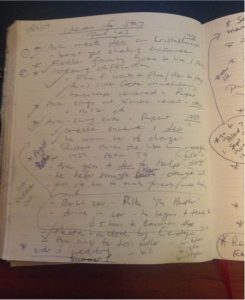
My chapter outlines are usually very brief, and I develop them further just before I write them. However, sometimes I need to plan a whole section of a novel quite carefully before I write it. I generally find that, the more complex the novel, the more I need to plan.
It does, of course, help if you understand exactly what a plot is.
So what is a plot?
At its simplest, a plot is the series of events in a story.
Usually, this series of events is driven by the protagonist’s attempt to RESOLVE a source of CONFLICT. The plot is therefore a chain of interconnected events caused by the protagonist’s actions and reactions to a problem presented in the opening scenes of the novel.
• This means a plot works in two ways – what is happening (i. the sequence of events) and why it is happening (cause and effect of what is happening).
• Character and plot are therefore inextricably entwined, because the personality of your characters will determine how they react to any given situation.
To plot is to therefore quite simply to conceive and arrange the action and incidents of a story.
Most people have no trouble thinking up the sequence of events in their story (though it may take some time), but its arranging them in the best possible sequence that may make all the difference to the story. Here are a few tools to help.
First, identify your protagonist. This is not always easy! Then ask yourself, what is their objective? What do they want? And what stands in their way? Most stories can be reduced down to a very simple formula:
Protagonist + Objective + Obstacles = Story
This is sometimes expressed as:
Character + Desire + Conflict = Story
i.e. someone wanting something that is hard to get
Usually, identifying your protagonist also means you need to identify your antagonist. The earlier you do this, the easier your planning will be and the more focused your writing.
Then you need to ask yourself, what is your protagonist's goal? What problem do they seek to solve? Your story is your protagonist's journey to reach that goal (or to try and fail, depending on what type of book you are writing). The longer the book, the more obstacles that lie in their way.
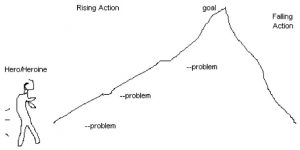
When I'm teaching story structure, I often draw this diagram to give my students a sense of what Rising Action is. It basically means each major scene is more dramatic, more intense, more suspenseful than the scene that came before it, compelling the reader to read on to find out what happens. If you are writing a comic novel, then each scene should be funnier and faster-paced than what came before. If you are writing a tragedy, the opposite is true - you must have a sense of the protagonist descending ever deeper into darkness and failure.
Next you need to think about what is the best structure for your story. There are two basic structures.
The first is called the episodic structure, used most often in narrative non-fiction, memoir, autobiography, biographical fiction, and in novels like Anne of Green Gables, Jane Eyre, Cold Mountain or Shantaram.
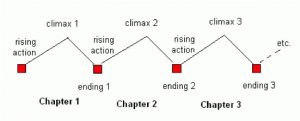
Basically, each chapter is like a short story, complete within itself. Each chapter has its own internal structure, with a sense of rising tension towards a point of climax but ending on a note of resolution.
Most novels, however, have a narrative arc. This is usually expressed as:
Exposition – Rising Action – Climax – Falling Action – Denouement
I draw mine like this:
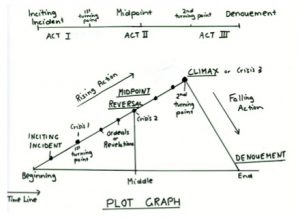
Here is the narrative arc expressed in greater detail:
1. set-up scene – a scene of normal life or “the ordinary world”. Often called EXPOSITION. If I have such a scene at all, I try and keep it as short as possible.
2. Inciting Incident – the true beginning – sets story in motion. Called the “call to adventure” in Joseph Campbell's The Hero's Journey.
3. period of turmoil/confusion. Campbell called it “refusing the call”
4. The First Turning Point (must happen within the first 25% of action). Campbell suggested a story at this point often involves a “meeting of the mentor” and then “acceptance of the call, which leads to the protagonist crossing "the First Threshold". Usually it is a moment of decision, or realisation, which leads to a momentous step being taken. I like to think of it as a gateway into a new state of being, a moment of psychological change.
5. Rising Action – a series of incidents, each increasing in tension and suspense. Joseph Campbell called this 'The Road of Trials' which I like, as it gives the sense of ever increasing difficulties. I normally like to plan the Road of Trials quite carefully, making sure that each scene or incident has a narrative function - each event is a revelation to be understood, an obstacle that must be overcome, an ordeal to endure, a lesson to be learned. I like the outer journey to reflect the inner journey of the protagonist's process of change and transformation.
6. The Midpoint Reversal (or Second Turning Point) - this is often often the darkest point in story, a moment in which the protagonist fails and feels they cannot go on. I like to put a big dramatic scene here, to avoid what I call 'the mid-book slump'. There can be a reversal of intention here , or a moment of new insight and self-realisation – a new approach or direction or location – or even a complete change in narrative position. In my novel Bitter Greens, I put the section told from the witch's point of view here. I thought of it as the dark heart of the novel.
7. Rising Action continues8. The Climax - sometimes called the Third Turning Point. This is a moment of extreme danger or darkness in which the character’s inner and outer journey both reach a key turning point – it is the point of highest tension in the novel when the protagonist either achieves their goal, or fails. It often involves a ‘symbolic’ death – the death of a friend or companion, or the maiming of protagonist (think of Frodo's finger, Luke Skywalker's hand). This is the moment of Crisis & Resolution and usually results in the final transformation of the character.
9. Falling Action – the chase. May be as exciting and dangerous as Rising Action, but is usually must shorter.10. The Denouement (sometimes called the Coda). This should be fairly brief, and be in contrast to the high tension beforehand. It is usually a small scene that shows that all has been returned to normal, order has been restored, the problem is solved, the goal is achieved and now the protagonist is reaping the rewards. It often mirrors the opening scene of "Ordinary Life".
I usually reduce this narrative arc down to its five most significant points.
1. Inciting Incident
(happens at or near 0% of the action)
2. First Turning Point
(happens at or before 25% of the action)
3. Midpoint Reversal
(happens at or near 50% of the action)
4. Crisis & Resolution
(happens at or after 75% of the action)
5. Coda
(happens at or near 100% of the action)
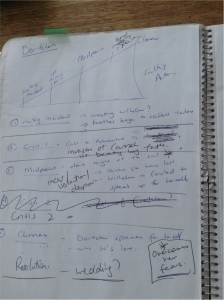
An early narrative arc plan for The Wild Girl
This really helps me plan out the novel, and know how much to write.
For example, if I was planning a novel of 120,000 words, the key turning points would happen at 30,000 words, 60,000 words and 90,000 words.
My chapters are usually around 3,000 words long, so I know I need around 10 chapters between each turning point (unless I am writing a children's book, in which case my chapters are half the length).
If I write a chapter a week, I can take ten weeks to write each section. That's 40 weeks in total.
If I write two chapters a week, it will take me only twenty weeks.
(Though I will always set aside more time than this, because I know that there will be weeks when I am sick, or touring, or the writing does not come easily, and so I always leave a few extra weeks for anything unexpected.)
I therefore have a good idea of how long it will take me to write a first draft. I can set myself weekly word targets, and if I fail one week, I can try and catch up the next week. If I find that one section is running on far too long, I can stop myself, and either reassess my plan or reassess my writing. I can judge whether I am spending too much time on sub-plots, or minor characters, and I can avoid that horrible realisation that you have written far too much and need to cut 60,000 words. (Been there, never want to do it again.)
Of course, there is much more to successfully planning a novel than just this one technique. I use lots more. Let me know what you want to know & I will try and answer it for you in another blog.
PLEASE LEAVE A COMMENT - I LOVE TO KNOW WHAT YOU THINK!








